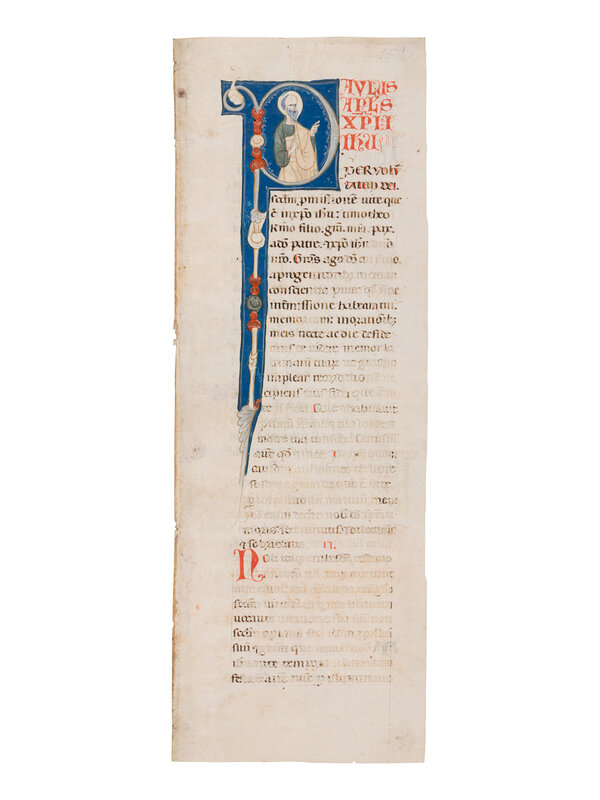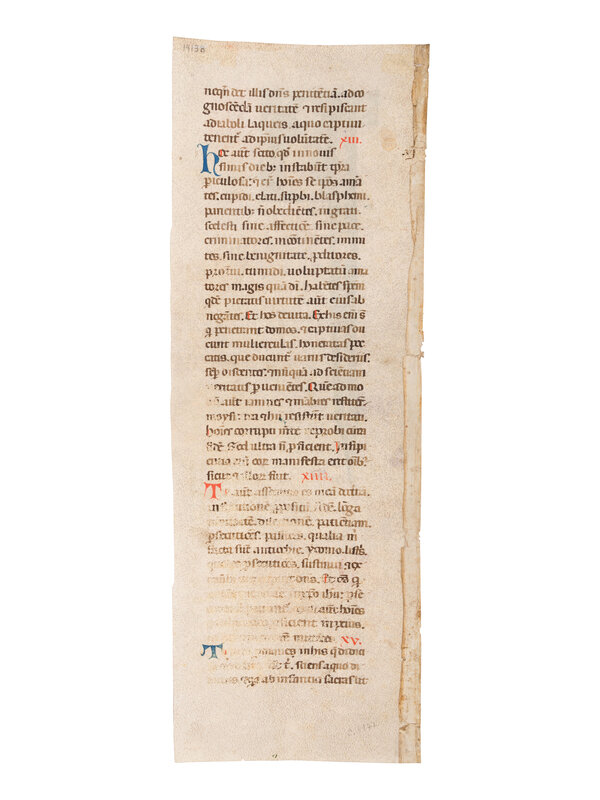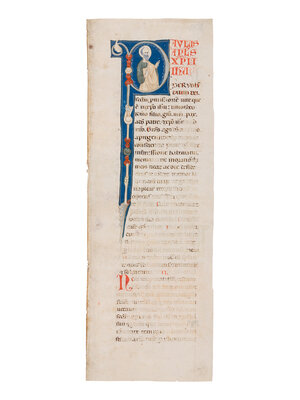Lot 6
CIRCLE OF THE MASTER OF BAGNACAVALLO & THE MASTER OF IMOLA (active Italy, Bologna, 2nd half of 13th-century) A partial leaf from an “Atlantic” Bible, with historiated initial ‘P’ of St. Paul, in Latin, illuminated manuscript on parchment [c. 1270]"
Sale 2033 - Western Manuscripts and Miniatures
Jun 27, 2024
10:00AM CT
Live / Chicago
Own a similar item?
Estimate
$6,000 -
8,000
Lot Description
CIRCLE OF THE MASTER OF BAGNACAVALLO AND OF THE MASTER OF IMOLA (active Italy, Bologna, second half of thirteenth century)
A partial leaf from an “Atlantic” Bible, with a historiated initial ‘P’ of St. Paul, in Latin, illuminated manuscript on parchment [Italy, Bologna, c. 1270]
A partial leaf from an “Atlantic” Bible, with a historiated initial ‘P’ of St. Paul, in Latin, illuminated manuscript on parchment [Italy, Bologna, c. 1270]
Imposing illumination of St. Paul standing, three-quarter view, related to a group of sister leaves from a dismantled “Atlantic” Bible.
465 x 164 mm. Partial leaf, ruled in brown ink for one column (of originally two) with 40 lines on the recto and 41 lines on the verso, in brown ink in a large rounded early gothic bookhand, textual divisions numbered in red, four two-line initials alternately in red and blue, opening words of text in red capitals and other opening words in capitals touched in red, ONE VERY LARGE HISTORIATED INITIAL in grey, beige, red, and green on blue ground, with white tracery, in leafy designs with stems winding round and extending far down the inner margins (brown ink faded through most of the lower part, browning on the sewing edge, minor spots, a few minor worm holes, tape stains at the two corners of the upper border of the verso, else in very good condition).
The present partial leaf is one of six in the McCarthy Collection, along with another seven sister leaves, that were excised from what must have been a large Bible in use during meals in a refectory, when the monks read the biblical texts aloud. It contains the beginning of the Second Epistle of Paul to Timothy, reading on the recto from the rubric and beginning of 2 Timothy 1:1, “Paulus Apostolus Christi I Ihesu: per voluntatem Dei,” to 2 Timothy 3:15 on the verso, “et quia ab infantia sacras lit[teras]…” The Epistle is introduced by a large historiated initial ‘P’, for “Paulus,” which depicts Saint Paul preaching in a green tunic with a yellow-brown cloak.
Fragments from this large refectory Bible have been associated with the Master of Bagnacavallo, named after the choirbooks illuminated by his workshop in Bagnacavallo (Biblioteca Comunale Taroni, MS 1-3). The Master also contributed to the illumination of another four-volume refectory Bible, datable around 1270 (Cesena, Biblioteca Malatestiana, MS D.XXI.1). The oeuvre of the Master of Bagnacavallo, like that of his contemporary the younger Master of Imola, should perhaps be perceived as the product of a general style rather than of a single artist.
Various aspects of their two styles reappear in similar contexts in Umbria and in various centers in Tuscany, such as Arezzo and Florence. The present leaf shares close stylistic affinities with the illuminations of the three Bagnacavallo Antiphonals. However, compared to the miniatures in that series, the form here is rendered in a relatively simplified manner, as the face is drawn with a few spare lines which hardly produce any relief. Nevertheless, there are certain consistent types and stylistic features among the different representations of St. Paul that survive from these: the relatively narrow face with its bulbous forehead and the characteristically pointed beard, articulated by a few white locks joining at the point.
A similar style reappears in miniatures due to the Florentine illuminator called the Master of Sant’Alessio in Bigiano, known also as the Maestro Geometrico, who painted large sections of the choirbooks for Santa Maria Novella in Florence (Florence, Archivio di Santa Maria Novella, Cor. E and F). Their style is very close, regarding especially the summary abstraction of the forms, demonstrating the interregional character of illumination in the third quarter of the thirteenth century.
It is interesting to note that many works from the Master of Bagnacavallo group, as well as those of their Tuscan alter ego, the Master of Sant’Alessio in Bigiano, were produced for the Franciscan order. This might be an indication that the workshops working in the style associated with the Masters of Bagnacavallo and of Imola benefited from a privileged link to the order.
Provenance
(1) Esther Rosenbaum, New York.
(2) Sotheby’s, London, 25 April 1983, lot 20.
(3) Longari Collection, Milan, no. 2.
(4) Jörn Günther, Hamburg, March 2003, acquired by:
(5) Robert McCarthy, London, MS BM 1413.
Sister leaves
The leaf has twelve companions known to us in several private and public collections. Among these is one from the Breslauer collection (sold at Christie’s, 11 December 2002, lot 1), and five further in the McCarthy collection, published together with the present one as no. 20 in his catalogue (see below). The parent manuscript, an imposing 13th-century Italian Atlantic Bible, was dismembered at an unknown date before then (for a partial reconstruction see Freuler 2013, pp. 154-159). Most of the surviving fragments come from the Epistles of St. Peter and St. Paul. Except for a leaf with the Epistle of Jude and two further pages in a private collection, which are complete with the text in two columns, all the remaining fragments lack their second column.
LITERATURE
On the present leaf and parent manuscript, published: William M. Voelkle and Roger S. Wieck, The Bernard H. Breslauer Collection of Manuscript Illuminations, New York, 1992, no. 56, p. 156; Milvia Bollati, Una collezione di miniature italiane. Dal Duecento al Cinquecento, Milan, 1994, pp. 13, no. 1; Les Enluminures, Catalogue 10, Paris, 2001, no. 16, pp. 46-47; Gaudenz Freuler, Italian Miniatures from the Twelfth to the Sixteenth Centuries, Milan, 2013, pp. 154-159; Gaudenz Freuler and Georgi Parpulov, The McCarthy Collection, Vol. I, Italian and Byzantine Miniatures, London, 2018, no. 20e, pp. 63-69 (with further literature).
We are grateful to Gaudenz Freuler for permission to quote from his catalogue for this entry. Freeman’s | Hindman thank Senior Consultant Sandra Hindman and Elliott Adam for their assistance in preparing this sale.
The Collection of Robert McCarthy
Condition Report
Contact Information



